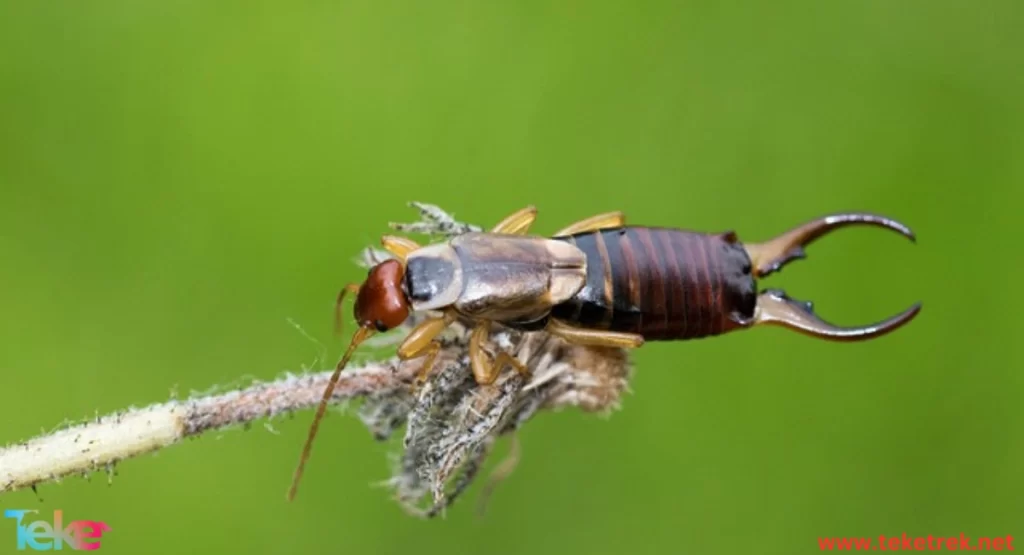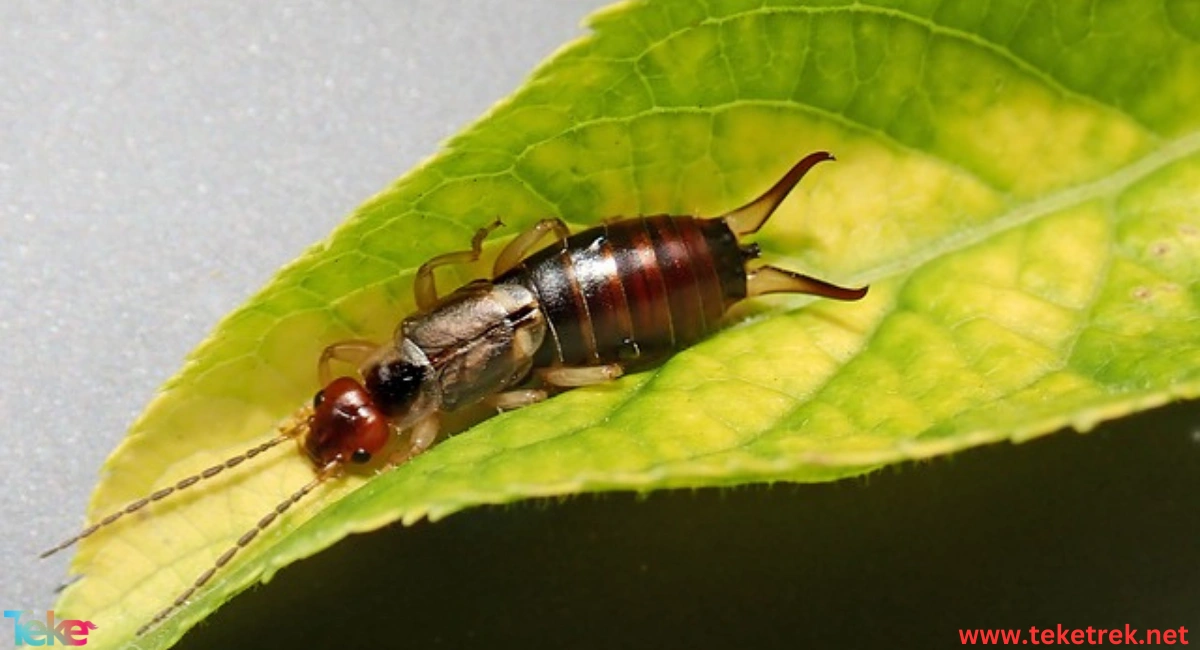Earwigs, also known as pincher bugs, are small insects that primarily live outdoors but occasionally find their way into homes. Although they don’t pose a significant threat to humans, they can cause problems in gardens by damaging plant leaves and flowers. In this article from the Teke Tek website, we will talk about earwigs, their life stages, and some important facts about them.
Appearance and Anatomy
- Earwigs belong to the order Dermaptera
- Their bodies consist of three distinct parts: the head, thorax, and abdomen.
- Most earwig species have a single pair of wings located under protective wing covers (elytra), but they rarely use them for flying.
- They have six legs, two antennae, and distinctive pincers (cerci) at the end of their abdomen.
- The pincers are used for capturing prey and grasping objects.
Reproductive Life Cycle
- Egg Stage:
Female earwigs carefully carry their eggs until they find a suitable location to deposit them.
Typically, they lay between 20 to 60 eggs at once.
The female licks each egg individually to prevent fungal growth, ensuring successful hatching.
- Nymph (Hatchling) Stage:
After hatching (usually within about seven days), the nymphs enter the larval stage.
The female cares for the nymphs until their first molt.
Nymphs undergo four to six molts to reach maturity.
- Molting (Ecdysis):
Molting involves shedding the old exoskeleton and growing a new one.
During this process, nymphs grow larger and eventually develop adult features, including wings.
- Adulthood:
Earwigs reach maturity after approximately one year from egg hatching. They become sexually active and continue the reproductive cycle.

Habitat and Behavior
- Earwigs are semi-social creatures that often gather in groups.
- They prefer moist environments and thrive in warm climates.
- Outdoors, you can find them under damp leaves, garden mulch, or grass clippings.
- Although earwigs primarily stay outdoors, they may seek refuge indoors during rainy weather or when searching for hiding spots near water sources (such as kitchens and bathrooms).
- Earwigs are nocturnal, spending their days resting and becoming active at night.
- Their primary activities include foraging for food and hunting prey.
Diet
- Earwigs are carnivorous, feeding on small insects and sometimes dead organic matter.
- When prey is scarce, they happily consume grass, flowers, and other plant material.
- If they find their way indoors, they may feed on dry goods like flour or even biscuits if available.
Common Earwig Species
European Earwig (Forficula auricularia)
- Measures about 12 to 15 mm in length.
- Rarely uses its wings for flight.
- Digs underground burrows to survive during winter.
Striped Earwig
- Dark brown with vertical stripes running from its head to the thorax.
- Approximately 25 mm long.
Marine Earwig
- Dark brown or black with a yellow abdomen.
- Typically found in coastal areas, where it burrows in damp sand and feeds on other insects.
- Despite its proximity to water, it cannot swim.


The Role of the Earwig in the Ecosystem:
Despite its small size, the earwig is an effective ecological player. It is a scavenger insect that helps clean the environment of organic debris. It usually lives in moist, dark areas such as under rocks, in decaying tree trunks, and beneath decomposing leaves, where it finds both food and shelter from predators. One of the key roles of the earwig is feeding on dead insect remains and organic waste, which aids in their decomposition and speeds up the recycling process of materials in the soil. It also feeds on the eggs of harmful insects such as aphids and destructive garden pests, helping to reduce their numbers and making the earwig an indirect ally to farmers.
How It Helps Eliminate Harmful Insects and Organic Waste:
The earwig is nocturnal, making it effective at hunting its small prey under the cover of darkness. It feeds on mosquito larvae, insect eggs, fungi, and algae that grow in damp environments. Additionally, it helps break down fallen leaves and plant debris, turning them into beneficial organic matter for the soil. From this perspective, the earwig is an integral part of the ecological chain that contributes to maintaining soil fertility and ecosystem health.
Its Role in Maintaining Natural Balance:
Like any component of the food web, the earwig plays a dual role. On one hand, it is a predator of smaller creatures; on the other, it is prey to larger animals such as birds, frogs, and spiders. This biological balance helps regulate the population of different species. If the earwig were to disappear, there could be a surge in the number of harmful insects or a buildup of organic waste in the environment, which highlights its importance in the ecological system.
Ways to Prevent Earwigs from Entering Homes:
Despite their environmental benefits, earwigs can be a nuisance when found indoors. To prevent their entry, the following measures are recommended:
- Seal cracks and gaps: Block small openings around doors and windows, especially on lower floors.
- Reduce moisture: Since earwigs are attracted to humidity, using dehumidifiers and repairing leaking pipes reduces their presence.
- Remove decaying leaves: Clean gardens of fallen leaves and plant debris, especially near walls.
- Use low outdoor lighting: Bright lights attract insects to homes, increasing the chances of earwig entry. Lowering outdoor light levels can reduce their presence indoors.
Differences Between Male and Female Earwigs:
Males and females can be distinguished by the size and shape of their rear pincers:
- Males: Have curved, thicker forceps used for mating and defense.
- Females: Have thinner, straighter forceps used mainly to protect their eggs.
Behaviorally, males are more aggressive toward each other, particularly during mating season, while females often care for their eggs and young after hatching — a rare behavior in insects that reflects an advanced level of maternal care.
Myths and Misconceptions About Earwigs:
One of the most common myths is the belief that earwigs crawl into human ears to lay eggs — a claim without any scientific basis. In fact, these insects avoid dry places like human ears and prefer moist, dark environments. Another misconception is that earwigs are venomous or deliver painful bites. In truth, they are not poisonous and lack effective means of stinging or biting. Their rear pincers are only used for defense or holding prey and do not pose a threat to humans.
Can Earwigs Fly?
Earwigs have two pairs of wings — the outer pair is hard and protective, while the inner pair is delicate and intricately folded. However, they rarely use their wings for flying. This is because they rely more on crawling and their preferred habitats do not require flight. Thus, while they are structurally capable of flying, they only do so in rare situations, such as escaping danger. In normal conditions, earwigs do not fly.
Earwigs in Culture and Folklore:
Strange tales about earwigs are common across cultures. In Europe, they were called “ear insects,” which led to the myth that they crawl into ears and feed on the brain. In some Asian cultures, they symbolize persistence and determination due to their strong grip. In some folk stories, they were associated with magic or dark creatures because of their odd appearance and nocturnal habits.
Potential Harm to Gardens and Plants:
Although beneficial, earwigs can damage gardens if their numbers grow excessively, especially when there isn’t enough organic matter or prey. They may then start feeding on buds, flowers, and ripe fruits. To address this in an eco-friendly way, it’s recommended to use natural traps made from damp newspapers or to encourage natural predators such as birds and frogs, rather than resorting to pesticides that may harm other beneficial insects. These methods help preserve the ecological balance, where the earwig plays a vital role.
Differences Between Earwigs and Similar Insects:
Earwigs are sometimes confused with other insect species. Examples include:
- Pseudoscorpions: These have pincers but no tail or wings.
- Winged termites: These fly and live in moist places but do not have pincers like earwigs.
- Beetles: They may share the same environment but lack pincers or similar behaviors.
Identifying them depends on the shape of the pincers, movement patterns, and their habitat.
FAQ
- Do earwigs have wings?
Most earwig species have a single set of wings located on their thorax.
These wings appear almost non-existent to the naked eye, as they are hidden beneath the hard wing covers. But when the wing covers are opened, earwigs’ wings open to about 10 times the size of their wing coverts.
- What do earwigs do with their tweezers?
Earwigs use their pincers for a variety of activities, including seizing prey, intimidating predators, and fighting with each other.
Male earwigs typically have larger, more curved pincers compared to females’ straighter, narrower pincers.
- What attracts earwigs to homes?
Earwigs are nocturnal, active creatures that are attracted to light, so if you have a habit of leaving lights on late at night, earwigs can find a way into your home through any cracks, they may do so.
Earwigs sometimes enter homes when it starts raining outside, seeking refuge in dry hiding places.
- Why are they called earwigs?
Earwigs get their name because they have two long protruding pincers at the end of their bodies, which closely resemble scissors.
- How long do earwigs live?
The average lifespan of an earwig is one year.
- Are earwigs harmful to humans or pets?
In very rare cases, earwigs can bite a person or a pet.
- Do earwig bites hurt?
Earwigs do not carry pathogens and are not poisonous, so pinching them is usually harmless.
In very isolated cases, their pincers can break the skin of humans or pets.
A pinch can leave a small red mark that heals quickly.
- How to eliminate earwigs?
Through insecticides: Here you use the appropriate insecticides for this insect, and spray them on them, especially during the day, i.e. when they are active and appearing.
In conclusion, earwigs are intriguing creatures with unique features and play important roles in ecosystems. Let’s appreciate their diversity and contribute to their conservation by respecting all living organisms, including these small but significant insects. Preserving their habitats ensures long-term environmental health.






